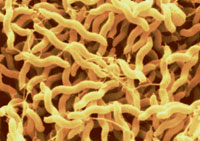Thinning flocks could increase campylobacter risk

Thinning out flocks of broilers to select for different weights increases the likelihood of infection with campylobacter, according to a new study from the European Food Safety Authority.
The report into the factors that contribute to the spread of campylobacter in live chickens and chicken meat, follows an earlier EFSA report, published last March, into the incidence of the bacterium in poultry across Europe.
That found that campylobacter was present, on average, in 76% of broiler carcases across the EU, based on over 10,000 samples from 561 slaughterhouses. The UK was very close to that average at 75%.
The new study, however, takes the analysis further, explaining that where batches of chickens arriving at the slaughterhouse are infected with campylobacter, their carcases are 30 times more likely to be contaminated too.
But it adds that “contaminated carcasses could also derive from non-infected batches, implying possible cross-contamination in the slaughterhouse”.
“Other factors were also found to be linked to an increased risk of contamination,” says the report. These include the age of the slaughtered chickens, with older birds more prone to contamination, and the time of year, with contamination peaking between July and September.
Depopulation or “thinning” practices in chicken flocks also emerged as a factor increasing the likelihood of infection in live birds arriving at slaughterhouses.
